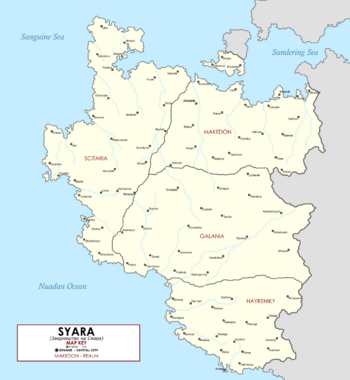Syara
The Commonality of Syara | |
|---|---|
|
Flag | |
| Motto: All-Mother Guide us. | |
| Anthem: To Our Homeland | |
 | |
| Capital and largest city | Zovahr |
| Official languages | Syara |
| Demonym(s) | Syara |
| Government | Parliamentary Federal Republic |
| Anita Beleska | |
| Area | |
• | 1,030,029 km2 (397,696 sq mi) |
| Population | |
• 2015 estimate | 163,520,400 |
• 2013 census | 161,578,224 |
| GDP (PPP) | 2020 estimate |
• Total | $6.81 trillion (4th) |
| GDP (nominal) | 2020 estimate |
• Total | $6.13 trillion (5th) |
| Gini (2020) | 33.65 medium |
| HDI (2020) | 0.889 very high |
| Currency | Drachma |
Syara (Syaran: Сијара), known officially as the Commonality of Syara (Syaran: Заедништво на Сиара), is a country lcoated in northwest Siduri. It's population is approximately 164.5 million as of 2020; Zovahr, the nation's capital, is its largest city.
Sitting at the northwestern top of the continent of Siduri, Syara forms the southern half of the 'mouth' of the Sundering Sea, which splits the continents of Siduri from Eracura in the north. It shares a land border with only two states; Ruvelka to the east and Delkora to the north, via the shared island of Libov. The Syaran Sea lies to the west, the Nuadan Ocean to the south, and the Sundering Sea to the north, which to the Syarans is often called "The Divide". Syara's coastline extends for nearly 11,000 kilometers, the fourth longest in Siduri.
Syara is considered to be a cradle of civilization, having been continuously inhabited since the third millennia BCE. Ancient Syara was noted for it's numerous contributions to philosophy, histroiography, political science, as well as scientific, mathematical, and ecological principles. Starting around the 9th century BCE Syara was divided into numerous city-states and small kingdoms which competed for power alongside warlike tribes the Bastarnae. The rise of the Makedonian Empire in the 3rd Century BCE unified most of Syara under Makedonian rule, while the Empire would expand it's borders across Siduri, reaching as far east as Knichus. Makedonian rule began to decline not long after it's apex in the 9th century, losing it's outlying rebellions to Quenminese rebellions and the rise of Islam in the south. The rise of the Arkoennite Empire in north central Siduri further weakened Makedonian rule. By the 14th century Makedon itself was subjugated the Arkoennites, though reduced to a tributary state the Makedonians retained a noticeable degree of autonomy, possibly reflective of their own treatment of their subjects. The decline the Empire saw the steady reduction of Hellenic culture in Syara and a steady rise of Slavonic linguistics from Scitaria and Galania. Despite it's occupation Syara continued it's position as a major trade partner, allowing it to serve as the crucible of an industrial revolution beginning in the 18th century. The fall of the Arkoennite Empire resulted in Syara's independence in 1715, after which Syara was transformed into four independent states vying for control. The threat of neighboring Ruvelka led to the Unification of Syara and the foundation of the Republic of Syara in 1875, which steadily grew in power and wealth as it continued to industrialize. Conflicts with Ruvelka and the Cacertian Empire profoundly impacted the development of the young Republic, and Syara's unexpected victory in the Divide War against the Cacertians served to inspire rampant Syaran nationalism. Syara's growing power and nationalist sentiment led to the outbreak of the Siduri War, which ended in Syaran defeat. The economic and psychological impact of the war contributed to the Broken Years, which undermined the stability of the Republic and resulted in the Refusal War. The rise of the nationalist and religiously fundamentalist Wardens overthrew the Royal Families of Syara's milennia old dynasties, re-establishing Syara as a Commonality in 1988. Under the leadership of Saša Mlinarić Syara rebounded from the war to become a major economic power throughout the 1990s, and by the 21st century boasted the largest economy in Siduri. Syara's economic fortune during this time, coupled iwth it's relative prosperity, is often referred to as the Warden Golden Years. Simmering tensions with neighboring Ruvelka led to two conflicts; the six day long Imerti Conflict that largely ended in Syara's favor, and the much more destructive Zemplen War which Syara lost and is considered to have ended the Golden Years.
Syara is a federal parliamentary republic and developed country with an advanced high-income economy, a high quality of life, and a high standard of living. It's economy is the largest in continental Siduri, and is a major international investor. Syara is member of the Organization of Tyrannic States, and observor state to the Commonwealth of Sovereign Nations, and boasts strong ties with Æsthurlavaj.
Etymology
The exact origins of the name "Syara" are not fully known, but modern historians believe the term originates from the Archaic Galanian "Sebera", meaning "our land" or "our home". In modern Syaran the country is called Sijara (Сијара) casually, or Siara (Сиара) formally, when in conjunction with the term "Commonality of". When Syara came to be commonly used by the majority of the population to describe their home is unknown, but by the 1875 the name was officially recognized as the name of the nation in the Conference of Pella, although it had been in use for centuries by then.
History
Geography and Climate
Syara is located in north-western Siduri, forming a "corner" of the continent. Mainland Syara is roughly 250 kilometers from Eracura, forming the western "mouth" of the Sundering Sea. The Syarans have called the Sundering Sea the "Divide" since antiquity. Syara borders only one another nation on the continent, Ruvelka, with whom Syara has long running territorial disputes. Syara's border with Ruvelka is approximately 1,953 kilometers long. Syara itself has a total land area of roughly 2,100,000 million square kilometers. It has the third largest coastline in Siduri, behind Nalaya and Gylias. Syara's tallest mountain is Mount Xena located in Makedon, while it's longest river is the Rioni, which originates in the Ruvelkan Kurilla Mountains and runs south-west through Zemplen into Galania before depositing into the Thanor Bay.
Syaran topography varies by Realm. Makedon is dominated by the Makedonian Highlands which contain Mount Xena and form the origin of many of Syara's northern rivers. The Highlands have historically formed the boundary between Makedon and Galania. The Highlands sprawl westward into the Lycian Mountains that form the "spine" of Scitaria and lead into the Mysian Peninsula. The Makedonian Highlands stretch north until they level out and form the Desopya Coastal Plain along Makedon's northern coast with the Sundering Sea.
The Makedonian Highlands fade quickly south, forming what has been termed the "Great Valley" of Galania, which are domianted by seasonally flooded plains fed by multiple rivers, the largest of which is the Rioni. Galania is the flattest territory in Syara, which extends west into Scitaria and contains Syara's largest interior body of water, Lake Amant. The gentle rolling hills and plains of Galania form Syara's breadbasket, and the core of Syara's extensive agricultural industry.
The Great Valley extends south until it ends in Hayreniky, where the Southern Highlands begin. Known simply as the Hayreniky Highlands, or the Clan Mountains, Hayreniky is the extension of the Matra Mountains that define the border between Ruvelka and Mansuriyyah. The coast of Hareniky is dominated by marshes and lagoons.
